Push–Pull Mechanism of Attention and Emotion in Children with Attention Deficit Hyperactivity Disorder
Abstract
1. Introduction
- Do children with ADHD exhibit atypical attentional-orienting functions, indicated by a lack of attentional capture effects towards threatening stimuli?
- Are the atypical orienting functions in children with ADHD modulated by their anxiety levels?
2. Experiment 1
2.1. Materials and Methods
2.1.1. Participants
2.1.2. Continuous Performance Task (CPT)
2.1.3. State-Trait Anxiety Inventory: STAI-X I, II
2.1.4. Procedures
2.1.5. Statistical Analysis
2.2. Results
3. Experiment 2
3.1. Materials and Methods
3.1.1. Participants
3.1.2. Tasks and Procedures
3.2. Results
4. Discussion
Author Contributions
Funding
Institutional Review Board Statement
Informed Consent Statement
Data Availability Statement
Conflicts of Interest
References
- American Psychiatric Association. Diagnostic and Statistical Manual of Mental Disorders (DSM-5®); American Psychiatric Pub.: Washington, DC, USA, 2013. [Google Scholar]
- Cho, S.C.; Kim, B.N.; Kim, J.W.; Rohde, L.A.; Hwang, J.W.; Chungh, D.S.; Shin, M.S.; Lyoo, I.K.; Go, B.J.; Lee, S.E.; et al. Full syndrome and subthreshold attention-deficit/hyperactivity disorder in a Korean community sample: Comorbidity and temperament findings. Eur. Child. Adolesc. Psychiatry 2009, 18, 447–457. [Google Scholar] [CrossRef]
- Polanczyk, G.V.; Willcut, E.G.; Salum, G.A.; Kieling, C.; Rohde, L.A. ADHD prevalence estimates across three decades: An updated systematic review and meta-regression analysis. Int. J. Epidemiol. 2014, 43, 434–442. [Google Scholar] [CrossRef]
- Kim, S.-Y.; Hopfinger, J.B. Neural basis of visual distraction. J. Cogn. Neurosci. 2010, 22, 1794–1807. [Google Scholar] [CrossRef] [PubMed]
- Posner, M.I. Orienting of attention. Q. J. Exp. Psychol. 1980, 32, 3–25. [Google Scholar] [CrossRef]
- Fan, J.; McCandliss, B.D.; Sommer, T.; Raz, A.; Posner, M.I. Testing the efficiency and independence of attentional networks. J. Cogn. Neurosci. 2002, 14, 340–347. [Google Scholar] [CrossRef] [PubMed]
- Oberlin, B.G.; Alford, J.L.; Marrocco, R.T. Normal attention orienting but abnormal stimulus alerting and conflict effect in combined subtype of ADHD. Behav. Brain Res. 2005, 165, 1–11. [Google Scholar] [CrossRef]
- Mullane, J.C.; Corkum, P.V.; Klein, R.M.; McLaughlin, E.N.; Lawrence, M.A. Alerting, orienting, and executive attention in children with ADHD. J. Atten. Disord. 2011, 15, 310–320. [Google Scholar] [CrossRef]
- Kim, S.-Y. Attentional Functions and Dysfunctions in ADHD. Korean J. Cogn. Biol. Psychol. 2014, 26, 67–94. [Google Scholar]
- Johnson, K.A.; Robertson, I.H.; Barry, E.; Mulligan, A.; Dáibhis, A.; Daly, M.; Watchorn, A.; Gill, M.; Bellgrove, M.A. Impaired conflict resolution and alerting in children with ADHD: Evidence from the Attention Network Task (ANT). J. Child Psychol. Psychiatry 2008, 49, 1339–1347. [Google Scholar] [CrossRef] [PubMed]
- McDonald, S.; Bennett, K.M.B.; Chambers, H.; Castiello, U. Covert orienting and focusing of attention in children with attention deficit hyperactivity disorder. Neuropsychologia 1999, 37, 345–356. [Google Scholar] [CrossRef]
- Ortega, R.; López, V.; Carrasco, X.; Anllo-Vento, L.; Aboitiz, F. Exogenous orienting of visual-spatial attention in ADHD children. Brain Res. 2013, 1493, 68–79. [Google Scholar] [CrossRef]
- Wehmeier, P.M.; Schacht, A.; Barkley, R.A. Social and emotional impairment in children and adolescents with ADHD and the impact on quality of life. J. Adolesc. Health 2010, 46, 209–217. [Google Scholar] [CrossRef] [PubMed]
- Caillies, S.; Bertot, V.; Motte, J.; Raynaud, C.; Abely, M. Social cognition in ADHD: Irony understanding and recursive theory of mind. Res. Dev. Disabil. 2014, 35, 3191–3198. [Google Scholar] [CrossRef] [PubMed]
- Dan, O.; Raz, S. Response patterns to emotional faces among adolescents diagnosed with ADHD. J. Atten. Disord. 2018, 22, 1123–1130. [Google Scholar] [CrossRef] [PubMed]
- Birmingham, E.; Meixner, T.; Iarocci, G.; Kanan, C.; Smilek, D.; Tanaka, J.W. The moving window technique: A window into developmental changes in attention during facial emotion recognition. Child Dev. 2013, 84, 1407–1424. [Google Scholar] [CrossRef] [PubMed]
- Langton, S.R.; Law, A.S.; Burton, A.M.; Schweinberger, S.R. Attention capture by faces. Cognition 2008, 107, 330–342. [Google Scholar] [CrossRef] [PubMed]
- Parks, E.L.; Kim, S.-Y.; Hopfinger, J.B. The persistence of distraction: A study of attentional biases by fear, faces, and context. Psychon. Bull. Rev. 2014, 21, 1501–1508. [Google Scholar] [CrossRef] [PubMed]
- Mogg, K.; Bradley, B.P. A cognitive-motivational analysis of anxiety. Behav. Res. Ther. 1998, 36, 809–848. [Google Scholar] [CrossRef] [PubMed]
- Mogg, K.; Bradley, B.P.; De Bono, J.; Painter, M. Time course of attentional bias for threat information in non-clinical anxiety. Behav. Res. Ther. 1997, 35, 297–303. [Google Scholar] [CrossRef]
- Kim, S.-Y.; Shin, J.E.; Lee, Y.J.; Kim, H.N.; Choi, S.H. Neural evidence for persistent attentional bias to threats in patients with social anxiety disorder. Soc. Cogn. Affect. Neurosci. 2018, 13, 1327–1336. [Google Scholar] [CrossRef]
- Kim, M.; Kim, J.; Kim, S.-Y. Attentional Bias to Emotional Stimuli and Effects of Anxiety on the Bias in Neurotypical Adults and Adolescents. Sci. Emot. Sensib. 2022, 25, 107–118. [Google Scholar] [CrossRef]
- Ahmadi, M.; Judi, M.; Khorrami, A.; Mahmoudi-Gharaei, J.; Tehrani-Doost, M. Initial orientation of attention towards emotional faces in children with attention deficit hyperactivity disorder. Iran. J. Psychiatry 2011, 6, 87–91. [Google Scholar] [PubMed]
- Weissman, A.S.; Chu, B.C.; Reddy, L.A.; Mohlman, J. Attention mechanisms in children with anxiety disorders and in children with attention deficit hyperactivity disorder: Implications for research and practice. J. Clin. Child Adolesc. Psychol. 2012, 41, 117–126. [Google Scholar] [CrossRef] [PubMed]
- Jarrett, M.A.; Ollendick, T.H. A conceptual review of the comorbidity of attention-deficit/hyperactivity disorder and anxiety: Implications for future research and practice. Clin. Psychol. Rev. 2008, 28, 1266–1280. [Google Scholar] [CrossRef]
- Bishop, S.J.; Duncan, J.; Lawrence, A.D. State anxiety modulation of the amygdala response to unattended threat-related stimuli. J. Neurosci. 2004, 24, 10364–10368. [Google Scholar] [CrossRef]
- MacNamara, A.; Ferri, J.; Hajcak, G. Working memory load reduces the late positive potential and this effect is attenuated with increasing anxiety. Cogn. Affect. Behav. Neurosci. 2011, 11, 321–331. [Google Scholar] [CrossRef]
- Bloemsma, J.M.; Boer, F.; Arnold, R.; Banaschewski, T.; Faraone, S.V.; Buitelaar, J.K.; Faraone, S.V.; Buitelaar, J.K.; Sergeant, J.A.; Rommelse, N.; et al. Comorbid anxiety and neurocognitive dysfunctions in children with ADHD. Eur. Child. Adolesc. Psychiatry 2013, 22, 225–234. [Google Scholar] [CrossRef] [PubMed]
- González-Castro, P.; Rodríguez, C.; Cueli, M.; García, T.; Alvarez-García, D. State, trait anxiety and selective attention differences in Attention Deficit Hyperactivity Disorder (ADHD) subtypes. Int. J. Clin. Health Psychol. 2015, 15, 105–112. [Google Scholar] [CrossRef][Green Version]
- Park, J.Y.; Oh, J.M.; Kim, S.Y.; Lee, M.K.; Lee, C.R.; Kim, B.R.; An, S.K. Korean Facial Expressions of Emotion (KOFEE); Section of Affect & Neuroscience, Institute of Behavioral Science in Medicine, Yonsei University College of Medicine: Seoul, Repubic of Korea, 2011. [Google Scholar]
- Spielberger, C.D.; Gorsuch, R.L.; Lushene, R.E. Manual for the State-Trait Inventory; Consulting Psychologists: Palo Alto, CA, USA, 1970. [Google Scholar]
- Cho, S.; Choi, J. Development of the Korean form of the State-trait Anxiety Inverntory for Children. Seoul J. Psychiatry 1989, 14, 150–157. [Google Scholar]
- Richardson, J.T.E. Eta squared and partial eta squared as measures of effect size in educational research. Educ. Res. Rev. 2011, 6, 135–147. [Google Scholar] [CrossRef]
- Gonçalves, J.R.; Sleath, B.L.; Cerdeira, M.; Cavaco, A.M. Older people, medication usage and long-term care pharmacists: A retrospective cohort study. Eur. J. Hosp. Pharm. 2023; ahead of print. [Google Scholar] [CrossRef]
- Benjamini, Y.; Hochberg, Y. Controlling the False Discovery Rate: A Practical and Powerful Approach to Multiple Testing. J. R. Stat. Soc. Ser. B Stat. Method 1995, 57, 289–300. [Google Scholar] [CrossRef]
- Han, S.; Northoff, G. Culture-sensitive neural substrates of human cognition: A transcultural neuroimaging approach. Nat. Rev. Neurosci. 2008, 9, 646–654. [Google Scholar] [CrossRef] [PubMed]
- Konrad, K.; Neufang, S.; Hanisch, C.; Fink, G.R.; Herpertz-Dahlmann, B. Dysfunctional attentional networks in children with attention deficit/hyperactivity disorder: Evidence from an event-related functional magnetic resonance imaging study. Biol. Psychiatry 2006, 59, 643–651. [Google Scholar] [CrossRef] [PubMed]
- Fox, E.; Russo, R.; Bowles, R.; Dutton, K. Do threatening stimuli draw or hold visual attention in subclinical anxiety? J. Exp. Psychol. Gen. 2001, 130, 681–700. [Google Scholar] [CrossRef] [PubMed]
- Somerville, L.H.; Jones, R.M.; Casey, B.J. A time of change: Behavioral and neural correlates of adolescent sensitivity to appetitive and aversive environmental cues. Brain Cogn. 2010, 72, 124–133. [Google Scholar] [CrossRef] [PubMed]
- Berkowitz, L. On the formation and regulation of anger and aggression: A cognitive-neoassociationistic analysis. Am. Psychol. 1990, 45, 494–503. [Google Scholar] [CrossRef] [PubMed]
- Adams, R.B.; Gordon, H.L.; Baird, A.A.; Ambady, N.; Kleck, R.E. Effects of gaze on amygdala sensitivity to anger and fear faces. Science 2003, 300, 1536. [Google Scholar] [CrossRef] [PubMed]
- Adolphs, R.; Russell, J.A.; Tranel, D.A. A role for the human amygdala in recognizing emotional arousal from unpleasant stimuli. Psychol. Sci. 1999, 10, 167–171. [Google Scholar] [CrossRef]
- Waters, A.M.; Lipp, O.V.; Spence, S.H. Attentional bias toward fear-related stimuli: An investigation with nonselected children and adults and children with anxiety disorders. J. Exp. Child. Psychol. 2004, 89, 320–337. [Google Scholar] [CrossRef]
- Mowlem, F.; Agnew-Blais, J.; Taylor, E.; Asherson, P. Do different factors influence whether girls versus boys meet ADHD diagnostic criteria? Sex differences among children with high ADHD symptoms. Psychiatry Res. 2019, 272, 765–773. [Google Scholar] [CrossRef]
- Martel, M.M. Individual Differences in Attention Deficit Hyperactivity Disorder Symptoms and Associated Executive Dysfunction and Traits: Sex, Ethnicity, and Family Income. Am. J. Orthopsychiatry 2013, 83, 165–175. [Google Scholar] [CrossRef] [PubMed]
- Skogli, E.W.; Teicher, M.H.; Andersen, P.N.; Hovik, K.T.; Øie, M. ADHD in girls and boys–gender differences in co-existing symptoms and executive function measures. BMC Psychiatry 2013, 13, 298. [Google Scholar] [CrossRef] [PubMed]
- Rhodes, M.G.; Anastasi, J.S. The own-age bias in face recognition: A meta-analytic and theoretical review. Psychol. Bull. 2012, 138, 146–174. [Google Scholar] [CrossRef] [PubMed]
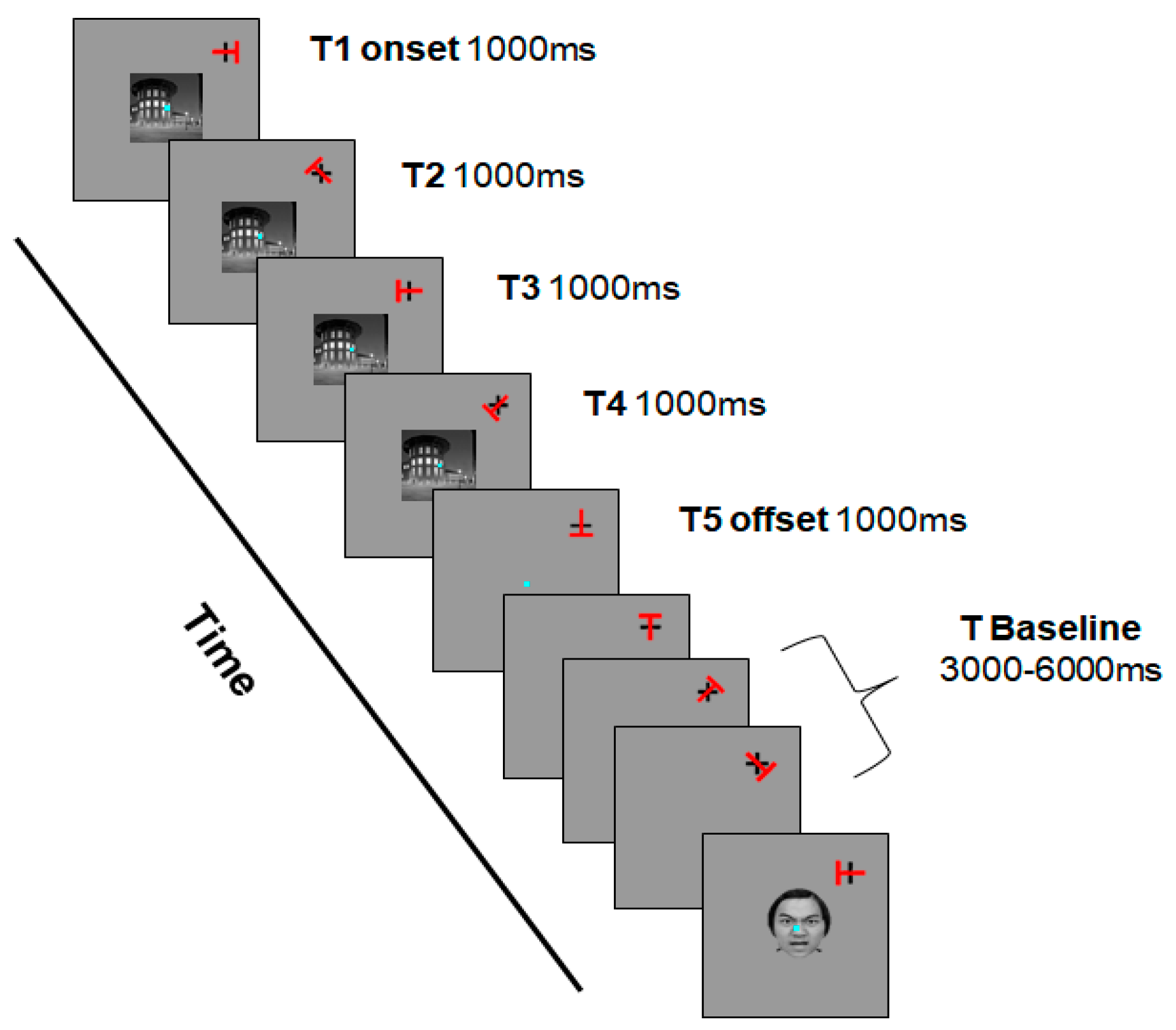
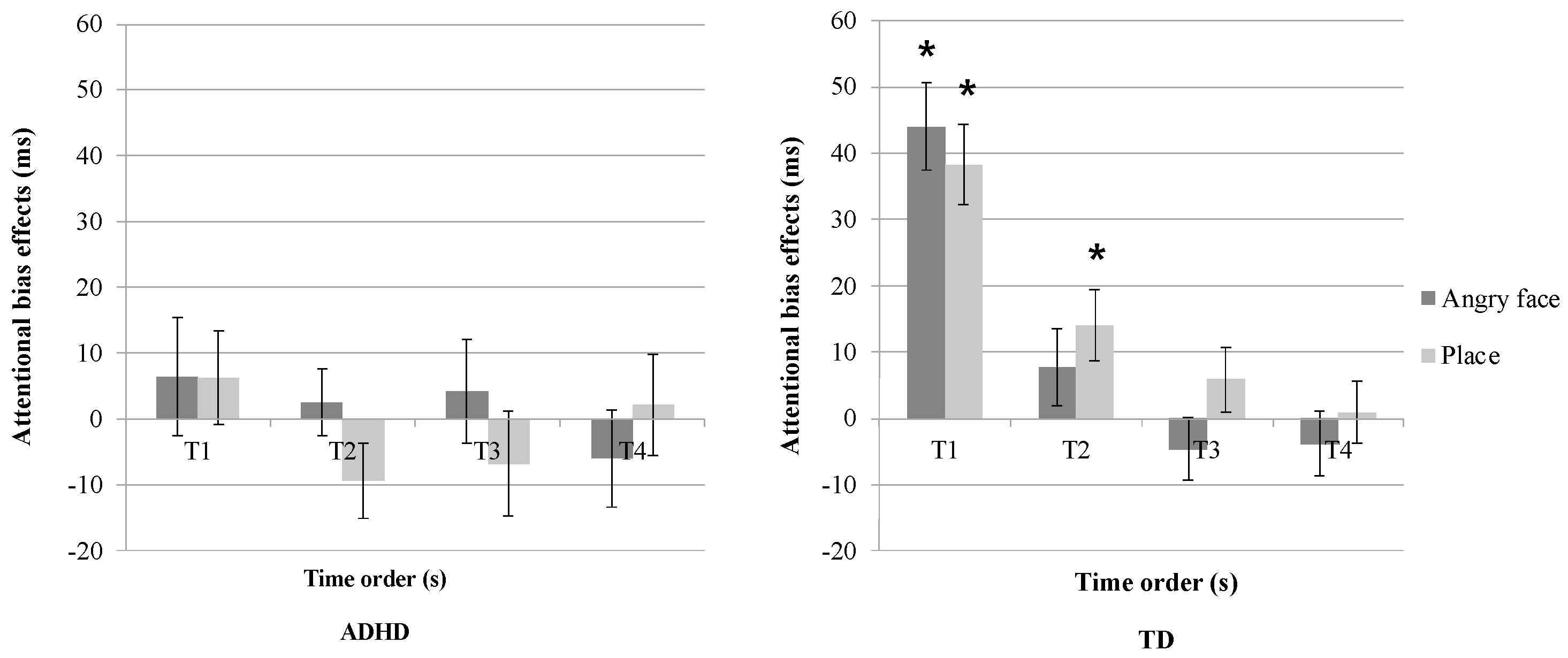
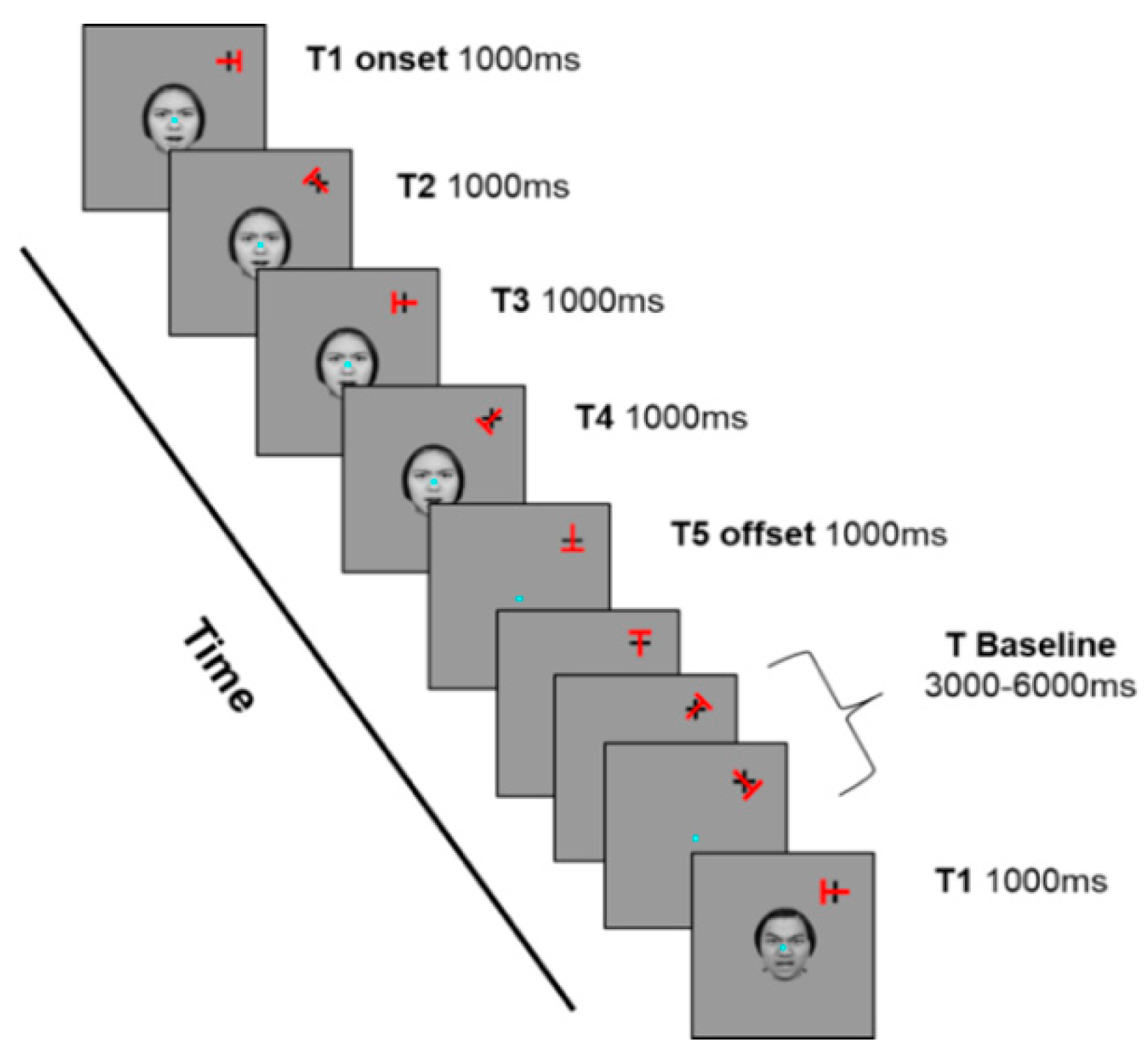

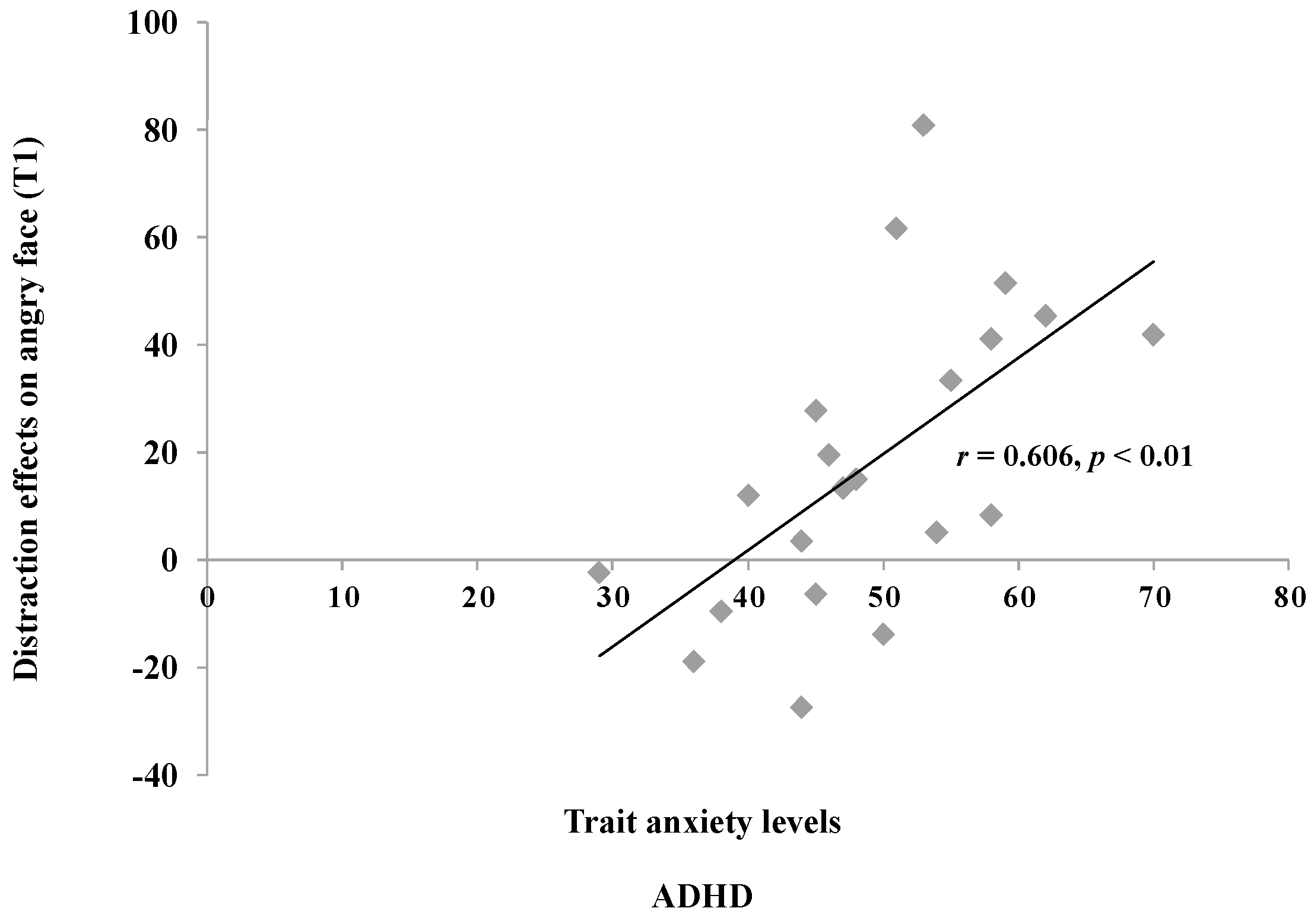
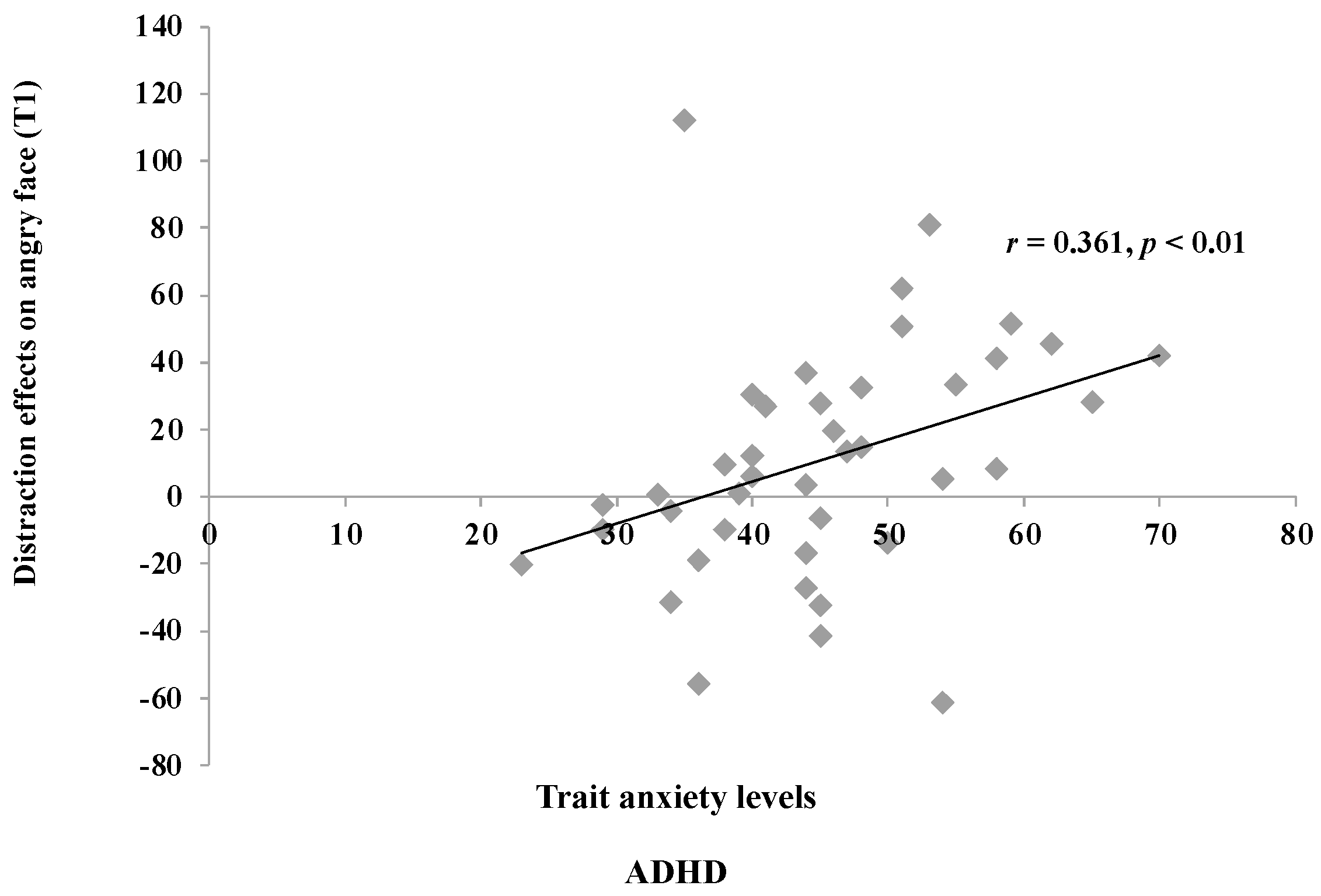
| Group | Sex | Age | State Anxiety | Trait Anxiety | |
|---|---|---|---|---|---|
| Boy (%) | Girl (%) | M (SD) | M (SD) | M (SD) | |
| ADHD (N = 20) | 16 (80) | 4 (20) | 13.17 (1.27) | 39.45 (8.37) | 40.90 (9.32) |
| TDC (N = 26) | 16 (62) | 10 (38) | 13.37 (1.51) | 35.88 (7.53) | 39.00 (7.71) |
| F | p | η2 | |
|---|---|---|---|
| Distractor | F(1, 44) = 2.41 | 0.13 | 0.05 |
| Time order | F(2.98, 131.10) = 18.67 | <0.001 | 0.30 |
| Group | F(1, 44) = 1.84 | 0.18 | 0.04 |
| Distractor × Group | F(1, 44) = 0.51 | 0.48 | 0.01 |
| Time order × Group | F(2.98, 131.10) = 9.20 | <0.001 | 0.17 |
| Distractor × Time order | F(4, 176) = 0.786 | 0.54 | 0.02 |
| Distractor × Time order × Group | F(3.51, 154.46) = 2.18 | 0.083 | 0.05 |
| Group | Sex | Age | State Anxiety | Trait Anxiety | |
|---|---|---|---|---|---|
| Boy (%) | Girl (%) | M (SD) | M (SD) | M (SD) | |
| ADHD (N = 21) | 17 (81) | 4 (19) | 12.64 (1.29) | 38.14 (7.84) | 49.14 (9.54) |
| TDC (N = 25) | 16 (64) | 9 (36) | 12.64 (1.07) | 35.24 (5.39) | 41.48 (9.14) |
| F | p | η2 | |
|---|---|---|---|
| Distractor | F(1, 44) = 3.91 | 0.05 | 0.08 |
| Time order | F(2.97, 130.85) = 11.83 | <0.001 | 0.21 |
| Group | F(1, 44) = 0.13 | 0.72 | 0.003 |
| Distractor × Group | F(1, 44) = 0.97 | 0.33 | 0.02 |
| Time order × Group | F(4, 176) = 0.997 | 0.41 | 0.02 |
| Distractor × Time order | F(2.81, 123.63) = 0.75 | 0.56 | 0.02 |
| Distractor × Time order × Group | F(2.81, 123.63) = 0.38 | 0.77 | 0.01 |
Disclaimer/Publisher’s Note: The statements, opinions and data contained in all publications are solely those of the individual author(s) and contributor(s) and not of MDPI and/or the editor(s). MDPI and/or the editor(s) disclaim responsibility for any injury to people or property resulting from any ideas, methods, instructions or products referred to in the content. |
© 2024 by the authors. Licensee MDPI, Basel, Switzerland. This article is an open access article distributed under the terms and conditions of the Creative Commons Attribution (CC BY) license (https://creativecommons.org/licenses/by/4.0/).
Share and Cite
Song, J.-H.; Kim, S.-Y. Push–Pull Mechanism of Attention and Emotion in Children with Attention Deficit Hyperactivity Disorder. J. Clin. Med. 2024, 13, 4206. https://doi.org/10.3390/jcm13144206
Song J-H, Kim S-Y. Push–Pull Mechanism of Attention and Emotion in Children with Attention Deficit Hyperactivity Disorder. Journal of Clinical Medicine. 2024; 13(14):4206. https://doi.org/10.3390/jcm13144206
Chicago/Turabian StyleSong, Ji-Hyun, and So-Yeon Kim. 2024. "Push–Pull Mechanism of Attention and Emotion in Children with Attention Deficit Hyperactivity Disorder" Journal of Clinical Medicine 13, no. 14: 4206. https://doi.org/10.3390/jcm13144206
APA StyleSong, J.-H., & Kim, S.-Y. (2024). Push–Pull Mechanism of Attention and Emotion in Children with Attention Deficit Hyperactivity Disorder. Journal of Clinical Medicine, 13(14), 4206. https://doi.org/10.3390/jcm13144206






